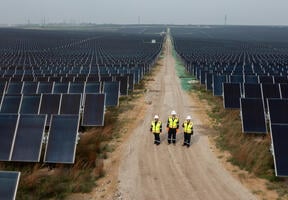New Delhi: Tackling the Challenge of Pollution
10 min read
New Delhi is the capital of India and forms part of the National Capital Territory (NCT) of Delhi, which has a population of more than 16 million. The Central National Capital Region, which encompasses NCT Delhi and the two new cities of Gurgaon and Noida, where the headquarters of major Indian and international companies are located, is home to some 25.7 million residents, making it the world’s fourth most populated region, behind Tokyo, Jakarta and Lagos. Delhi’s metropolitan area today has a larger population and makes a greater contribution to gross domestic product (GDP) than that of Mumbai (formerly Bombay), which now ranks sixth in the world.

© PRAKASH SINGH / AFP - The traffic jams created by automobiles, rickshaws and two-wheelers in New Delhi are a daily source of frustration.
Overlapping Cities
The distinction between Delhi and New Delhi, which today are used interchangeably, is a historical legacy. Delhi, also known as Old Delhi, was built by the Mughal dynasties in the 17th century and features the Red Fort, a large mosque and an intricate network of narrow streets dominated by dilapidated buildings. Virtually unchanged, Old Delhi is the touristic heart of the capital.
New Delhi, on the other hand, took shape in the early 20th century at the initiative of the British Empire following the decision to move the capital from Calcutta. Laid out in perfectly straight lines around the President’s Estate and the long Rajpath boulevard, New Delhi’s roads are very wide and bordered by bungalows and gardens. Apart from a few large buildings that now surround Connaught Place, New Delhi’s urban landscape has maintained its original look and serves as a symbol of India’s political .
The city’s modern-day expansion has taken place in two entirely new urban areas: Gurgaon in the southwest was built up from a village and Noida in the southeast was created from a blank slate, and even has an acronym for a name. In the absence of a true city blueprint, they group together state-of-the-art skyscrapers, malls, the headquarters of every major company and apartment buildings housing India’s rapidly growing middle class. The rest of the ring surrounding Delhi has been overtaken by a diverse mosaic of luxury mansions, housing developments and squatter settlements, called jhuggi-jhopri, which shelter migrants from rural areas and workers who have come with their families for construction jobs.
The Curse of Pollution
New Delhi is one of the world’s most polluted major metropolitan areas. Several factors contribute to the city’s pollution, including sand storms from the arid plains of Rajasthan, the practice of stubble burning in the surrounding countryside, the presence of several thermal power plants in the vicinity and the widespread use of by poor residents for heating and cooking. However, the main culprit is traffic, which has exploded in the Indian city. Delhi has four million registered cars and trucks – twice as many as in 2000 – and more than 1,000 new ones are registered each day. Counting two-wheelers and India’s famous threewheeled rickshaws, some 10 million motor vehicles circulate in the country’s capital. At rush hour, it can take nearly two hours to drive the 30 kilometers that separate New Delhi’s center from Gurgaon.
As a result, the Indian capital has a high level of fine particles, that is, particles with a diameter of less than 2.5 micrometers (μm)1. Their concentration, calculated in micrograms (μg)2 per cubic meter (cu.m), reaches an annual mean of 122 μg/cu.m in Delhi. By comparison, according to data from the World Health Organization (WHO)3, Beijing, Cairo and Paris have concentrations of 85, 57 and 18 μg/cu.m, respectively. In early November 2016, after the Hindu Diwali celebration during which participants light firecrackers and fireworks, the level reached 1,000 μg/cu.m.
It is important to note that smaller cities have even higher levels: Gwalior, located 350 kilometers south of New Delhi, has hit an annual mean concentration of 176 μg/cu.m and Allahabad has recorded 170 μg/cu.m. In terms of fine particles, India has 16 of the world’s 30 most polluted cities4.
One-Off Measures and the Development of Solar Power
The authorities have taken steps to reduce pollution in India, such as requiring tens of thousands of buses and rickshaws to convert to compressed natural gas, and restricting truck traffic to nighttime. Road space rationing strategies have also been tested and most thermal power plants have been relocated further away5. In addition, a subway was built – rather belatedly – and began operating in 2002. The network is currently being extended, as its coverage remains limited. Lastly, the government has confirmed India’s transition toward all-electric cars by 2030.
For India as a whole, the ultimate solution is to develop renewable energies, which would enable it to reduce its dependence on and oil to generate (see Feature Report: “India and Energy”). In 2015, the government launched a massive program to incorporate 175 gigawatts of renewable power into the grid by 2022. Solar power dominates the plans, with a new target of 60 gigawatts for solar farms and 40 gigawatts for rooftop systems. By contrast, France’s total installed photovoltaic capacity was less than seven gigawatts at end-2016.
Nevertheless, implementing these policies in the capital region is no easy task. Real estate is expensive and its speculative nature, which has made many of India’s fortunes, often prevents the development of both solar and wind farms. Rooftop systems have been very slow to get off the ground due to the cost of equipping existing buildings and a lack of government subsidy programs. In addition, Delhi’s extremely hot climate frequently leads to sudden upswings in demand, which are poorly suited to solar power’s intermittent output. Consumers and companies cope with frequent power outages by using generators running on fuel oil.
A Comprehensive Approach
Spurred by India’s Prime Minister Narendra Modi, who has already dramatically changed the of his home state of Gujarat, the Indian government has adopted a comprehensive approach to helping cities transition to greener energy, taking into account economic and social constraints as well as sound governance practices. As part of this approach, it has pitted the country’s cities against each other in a major urban planning competition of sorts, setting goals for them to reach together, including a 10% minimum target for solar energy, social diversity, funding feasibility, community participation, modern management practices and at least one “smart” solution, such as a traffic management system or . The most creative 100 or so cities will receive support to form a strategic network, particularly along the 1,500-kilometer-long corridor that separates Delhi from Mumbai.
Sources:
- One micrometer is equal to one millionth of a meter.
- One microgram is equal to one millionth of a gram.
- The WHO has set a fine particle limit of 10 μg/cu.m annual mean and 25 μg/cu.m 24-hour mean.
- Overview of cities worldwide – The Guardian
- According to the , coal still accounts for more than 70% of India’s power generation mix. However, the country has set a carbon-free electricity target of 40% by 2030.















